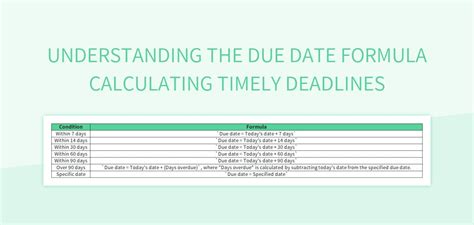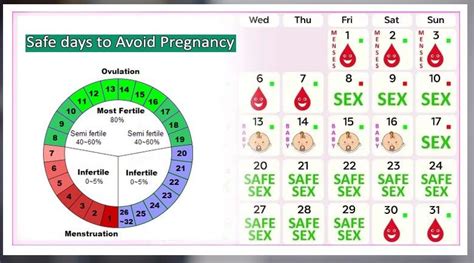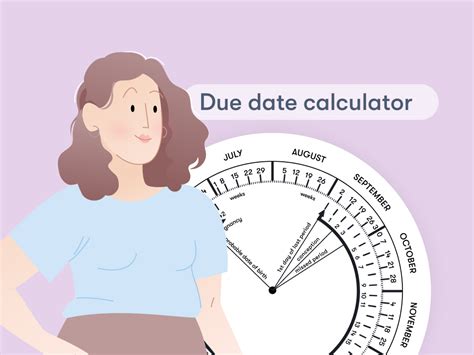Intro
Calculate your babys due date with ease using 5 simple methods, including ovulation tracking, ultrasound scans, and conception date estimation, for an accurate pregnancy timeline and childbirth preparation.
Calculating a baby's due date is an exciting milestone for expecting parents. The due date, also known as the estimated date of confinement, is the predicted date of delivery. Knowing the due date helps parents prepare for the arrival of their baby and allows healthcare providers to monitor the pregnancy and ensure a healthy delivery. In this article, we will explore five ways to calculate a baby's due date, providing a comprehensive guide for expecting parents.
The importance of calculating a baby's due date cannot be overstated. It helps parents prepare for the financial, emotional, and physical demands of parenthood. Moreover, knowing the due date allows healthcare providers to schedule regular check-ups, monitor the baby's growth, and identify potential complications early on. With the due date in mind, parents can plan for maternity leave, childcare, and other essential arrangements.
Calculating a baby's due date is a relatively straightforward process, but it requires accurate information about the mother's menstrual cycle and the date of conception. The most common method of calculating the due date is by using the first day of the last menstrual period (LMP). However, this method assumes a regular 28-day menstrual cycle, which may not be the case for all women. Other factors, such as the date of conception, ultrasound measurements, and physical exams, can also be used to estimate the due date.
Understanding the Basics of Due Date Calculation

To calculate a baby's due date, it's essential to understand the basics of human reproduction and fetal development. A normal pregnancy lasts approximately 40 weeks from the first day of the last menstrual period (LMP). The due date is typically calculated by adding 280 days to the first day of the LMP. However, this method assumes a regular 28-day menstrual cycle, which may not be the case for all women.
Factors Affecting Due Date Calculation
Several factors can affect the accuracy of due date calculation, including: * Irregular menstrual cycles * Conception date * Ultrasound measurements * Physical exams * Fetal developmentThese factors can influence the estimated due date, and healthcare providers may use a combination of these factors to determine a more accurate due date.
Method 1: Last Menstrual Period (LMP) Method

The LMP method is the most common way to calculate a baby's due date. This method assumes a regular 28-day menstrual cycle and that ovulation occurs on day 14 of the cycle. To calculate the due date using the LMP method:
- Determine the first day of the last menstrual period (LMP)
- Add 280 days to the first day of the LMP
- The resulting date is the estimated due date
For example, if the first day of the LMP is January 1, the estimated due date would be October 8.
Advantages and Limitations of the LMP Method
The LMP method is a simple and widely used method for calculating the due date. However, it has some limitations: * Assumes a regular 28-day menstrual cycle * Does not account for irregular menstrual cycles or conception date * May not be accurate for women with polycystic ovary syndrome (PCOS) or other reproductive disordersDespite these limitations, the LMP method remains a widely used and accepted method for calculating the due date.
Method 2: Conception Date Method

The conception date method is another way to calculate a baby's due date. This method uses the date of conception to estimate the due date. To calculate the due date using the conception date method:
- Determine the date of conception
- Add 266 days to the date of conception
- The resulting date is the estimated due date
For example, if the date of conception is January 15, the estimated due date would be October 22.
Advantages and Limitations of the Conception Date Method
The conception date method is a more accurate way to calculate the due date, especially for women who know the exact date of conception. However, it has some limitations: * Requires accurate knowledge of the conception date * May not be suitable for women who do not know the exact date of conception * Does not account for irregular menstrual cycles or other reproductive disordersDespite these limitations, the conception date method is a useful alternative to the LMP method.
Method 3: Ultrasound Method

The ultrasound method uses ultrasound measurements to estimate the due date. This method is typically used during the first trimester, when the fetus is still small. To calculate the due date using the ultrasound method:
- Perform an ultrasound scan to measure the fetal length
- Use a gestational age calculator to estimate the due date based on the fetal length
- The resulting date is the estimated due date
For example, if the fetal length is 10 cm, the estimated due date would be October 15.
Advantages and Limitations of the Ultrasound Method
The ultrasound method is a highly accurate way to calculate the due date, especially during the first trimester. However, it has some limitations: * Requires access to ultrasound technology * May not be suitable for women with multiple pregnancies or fetal anomalies * Does not account for irregular menstrual cycles or other reproductive disordersDespite these limitations, the ultrasound method is a valuable tool for estimating the due date.
Method 4: Physical Exam Method

The physical exam method uses physical exams to estimate the due date. This method is typically used during the second and third trimesters, when the fetus is more developed. To calculate the due date using the physical exam method:
- Perform a physical exam to measure the fetal height and abdominal circumference
- Use a gestational age calculator to estimate the due date based on the fetal measurements
- The resulting date is the estimated due date
For example, if the fetal height is 30 cm and the abdominal circumference is 100 cm, the estimated due date would be October 20.
Advantages and Limitations of the Physical Exam Method
The physical exam method is a useful way to estimate the due date, especially during the second and third trimesters. However, it has some limitations: * Requires access to a healthcare provider * May not be suitable for women with multiple pregnancies or fetal anomalies * Does not account for irregular menstrual cycles or other reproductive disordersDespite these limitations, the physical exam method is a valuable tool for estimating the due date.
Method 5: Online Due Date Calculators

Online due date calculators are a convenient way to estimate the due date. These calculators use algorithms to calculate the due date based on the first day of the last menstrual period, conception date, or ultrasound measurements. To use an online due date calculator:
- Enter the relevant information, such as the first day of the LMP or conception date
- The calculator will provide an estimated due date
- The resulting date is the estimated due date
For example, if the first day of the LMP is January 1, the estimated due date would be October 8.
Advantages and Limitations of Online Due Date Calculators
Online due date calculators are a convenient and easy-to-use way to estimate the due date. However, they have some limitations: * May not account for irregular menstrual cycles or other reproductive disorders * May not be suitable for women with multiple pregnancies or fetal anomalies * Requires access to a computer or mobile deviceDespite these limitations, online due date calculators are a useful tool for estimating the due date.
What is the most accurate method for calculating the due date?
+The most accurate method for calculating the due date is the ultrasound method, which uses ultrasound measurements to estimate the due date. However, the conception date method and physical exam method can also be accurate, especially when used in combination with the LMP method.
Can I calculate my due date online?
+Yes, you can calculate your due date online using an online due date calculator. These calculators use algorithms to calculate the due date based on the first day of the last menstrual period, conception date, or ultrasound measurements.
How accurate are due date calculations?
+Due date calculations are generally accurate, but they can vary depending on the method used and individual factors, such as irregular menstrual cycles or fetal anomalies. It's essential to consult with a healthcare provider to determine the most accurate due date.
In conclusion, calculating a baby's due date is an essential part of prenatal care. The five methods outlined in this article provide a comprehensive guide for expecting parents to estimate the due date. Whether using the LMP method, conception date method, ultrasound method, physical exam method, or online due date calculators, it's essential to consult with a healthcare provider to determine the most accurate due date. By understanding the basics of due date calculation and using the most accurate method, expecting parents can prepare for the arrival of their baby and ensure a healthy pregnancy. We invite you to share your experiences and ask questions in the comments below, and don't forget to share this article with your friends and family who may be expecting a baby.
